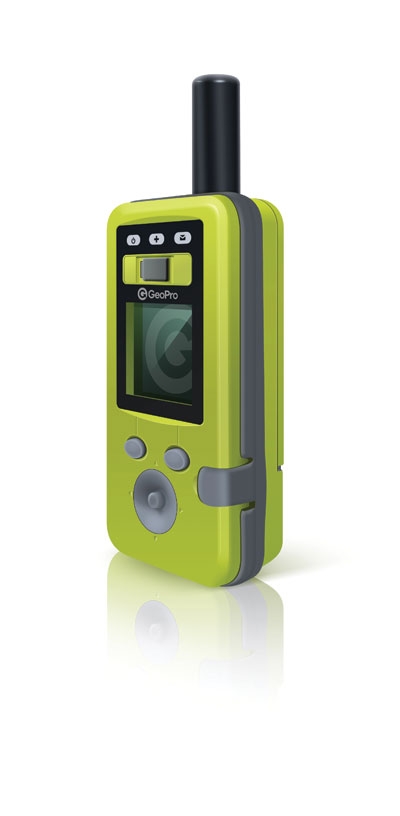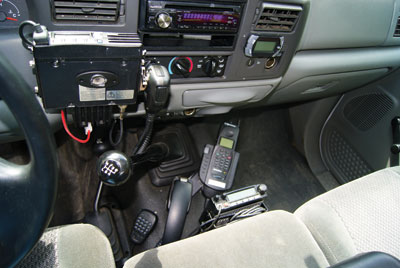
Features
Health and Safety
Sawmilling
Enhancing Logger Safety
Logging is a dangerous business, and the risks are even higher for “lone loggers”: the people working by themselves in the bush. This is why reliable two-way communications is vital to the industry and its workers. When accidents and injuries occur, two-way communications can sometimes be a logger’s only hope for quick outside assistance and rescue.
November 10, 2011 By James Careless
 Logging is a dangerous business
Logging is a dangerous businessThere are a number of two-way communications systems currently available to Canadian logging companies, both for lone loggers and logging crews. The bad news is that each system has its limitations. The good news is that innovative solutions have been developed to enhance the safety and reliability of these systems; making the life of loggers less dangerous.
Radio Dominates
Glenn Graham owns Timberline Radio Systems (www.timberlineradio.com) in Richmond, B.C. He supplies two-way communications products to the logging industry, so he knows what’s being used by loggers throughout western and northern Canada.
“There are two basic types of radio communications used in the industry,” Graham tells Canadian Forest Industries magazine. “The first type is Repeater Access, where the transmission from one truck radio is relayed to a tower equipped with repeater equipment that picks up the signal, and then rebroadcasts it over a wide area of terrain. This is especially necessary here in British Columbia where we have mountainous terrain.”
Most loggers, however, rely on two-way radios operating in “Simplex mode,” which means they talk to each other without the benefit of a signal-boosting repeater. “The disadvantage of Simplex mode is the inability to communicate over long distances, unless one truck is high atop a mountain and overlooking the area where another truck may be,” Graham says. “In most cases, Simplex mode is used on a road-by-road basis.”
At the Weyerhaeuser Company – which has Canadian logging operations in Alberta, B.C., Ontario and Saskatchewan – “all of our sites use two-way radios for communications between company personnel, between company and contractors and from contractor to contractor,” says spokesman Wayne Roznowsky. “Most units have a way of accessing a telephone line from their two-way radio for emergencies.”
Radio is also used in Newfoundland, where Corner Brook Pulp and Paper (CBPP) relies on VHF Simplex radio communications. “We have three licensed frequencies that we maintain,” says Deon Hamlyn, the company’s district operations supervisor. “Two of these channels are referred to as ‘Kilometre Channels’ and are used on various roads for trucks and commuting vehicles to call their locations while travelling along our road networks. The third channel is a private channel used by company staff. Contractors working for CBPP have licensed their own private VHF channels and have equipped their harvesting equipment with VHF radios.”
Pros and Cons
Without a doubt, two-way VHF/UHF radios remain the main choice for loggers; due to their portability, ease of deployment, range and overall cost. The downside is that “two-way radios suffer from ‘dead spots’, where the terrain prevents line-of-sight signals from reaching certain areas,” says MaryAnne Arcand, executive director of B.C.’s Central Interior Logging Association (CILA). “There’s also a lack of co-ordination on the frequencies and in the ‘code words’ used by loggers and other truckers. Now that mining trucks are starting to turn up on logging roads, the result is confused communications between radio operators that can result in accidents.”
There are two other communications options readily available to loggers; namely, cellular telephones and satellite. The problem with cellular is its business model: Cellular carriers build towers in urban areas and along main highways where subscriber numbers justify the cost, and not in the bush where there’s virtually no one to use them. This means that “cellular telephones are useless in remote areas such as logging camps and most logging resource roads,” says Timberline’s Graham.
This said, there are times when cellular networks can be accessed by loggers; either directly or by using repeaters to reach cellular towers. “All our units use cell phones to some degree, depending on the cell coverage in that area, “ says Weyerhaeuser’s Roznowsky. “Alberta uses cells more than anywhere else because of the coverage they have.[But] Satellite phones are used very little.”
Satellite phones are not popular with loggers for a number of reasons: Handsets and system access are expensive, plus reliability is declining as the satellites overhead age. “Once the satellites have reached their end-of-life cycle, their transponders stop working,” Graham notes.
This matters, because the transponders handle communications between the handset, the satellite, and the carrier’s main earth station. Fewer working transponders means fewer available telephone channels for loggers.
Fortunately, robust and reliable data-based satellite communications such as INMARSAT are available. They support Internet access, e-mail and Voice-over-IP satellite telephone service. “Internet communications in small, rural communities, logging camps, and even mobile logging trucks is becoming more popular every day,” says Graham. “The model short is very simple: A satellite dish combined with a modem – just like your ADSL modem – is situated at a ground station, usually at the camp. From the ground station, most operators then redistribute their signal using WiFi (Wide Area Wireless Networks) to various parts of the camp … and up and down their logging roads.”
Innovative Solutions
Even when they are working perfectly, two-way communication systems cannot guarantee a lone logger’s safety. The reason is that these systems require an injured logger to actively send out a message for help; something they cannot do when unconscious. Many logging companies require their loggers to check in on a regular basis; however, this system only works if there is someone assigned to monitoring radio check-ins. Otherwise, it could be hours before a missed check-in is noticed.
AC Global Systems of Trail, B.C. (www.acglobalsystems.com) offers a solution to this problem. Its “ISO CHQ” unit uses either GPS-enabled cellular or satellite networks to connect lone workers back to their company’s monitoring centre. Workers are required to push a “check-in” button on a small remote control unit on a regular schedule; sending back their real-time location every time they do. Should they miss a check-in, an alert is automatically sent out to the monitoring centre and other loggers working nearby.
“The ISO CHQ service is carried over the INMARSAT data satellite system, which is reliable and offers continuous coverage of Canada’s remote areas,” says AC Global VP Shaun Ashman. “We can hardwire the link between the remote and the monitoring centre to a truck or portable radio. The cost works out to between $1,400 and $1,800 a unit, plus $1.50 per minute airtime.”
B.C.’s Trucut Logging recently signed up for AC Global’s check-in service. “Safety is extremely important to us,” says company president Doug Nichol. “With the AC Global system, we know where our people are. If a faller doesn’t check in on time, the AC Global system tries to contact them. If there’s no response, we get an alarm and can send people to find out what’s going on quickly.”
Corner Brook Pulp and Paper has purchased three SPOT GPS receivers from Globalstar for use by employees working in remote areas. “These units are worn on the body and can be activated when an emergency occurs,” says Hamlyn. “During the initial setup of the device you must specify the emergency contact info so that the appropriate calls are made. These are in the testing phase now and so far so good.”
Lone loggers will soon be able to stay in touch using the Iridium-connected GeoPro Messenger (www.geoprosolutions.com). This is a BlackBerry-sized, GPS-enabled unit that supports two-way text messaging and alerts. The data is sent into a web-based interface that managers can use to track and communicate with workers in real time. When trouble occurs, a single button push will summon help, as will a missed check-in.
“You can actually see where your people are at all times, says GeoPro GM Bruce Marrett. “Anytime they need to check in, the Messenger will emit a tone. All they have to do is touch its LCD screen, and they are done.” The GeoPro device will cost US$699. Monthly service fees will vary by distributor, but the manufacturer expects them to be in the vicinity of US$35/month.
Tsunami Solutions’ SafetyLine Lone Worker Monitoring service (www.safetyline.ca) keeps an eye on workers on behalf of their employers. All that is required is the worker’s mobile phone: They log on to the SafetyLine system at the start of their shift, check in regularly throughout the day, and then log off when the day is done. Any deviations are flagged by the SafetyLine system and brought to the employer’s immediate attention.
“We provide a work alone monitoring “service” that uses the clients’ existing communications networks and products,” says company spokesman Kyle Touhey. “Our system works regardless of whether any one specific comm device/network is functioning or not, because the clients can simply switch over on the fly to using a different one. In fact, it is built into our service that there are contingencies if a particular user is out of communication for a period of time.”
Corner Brook Pulp and Paper has enhanced logger safety by implementing its “Working Alone” policy. “Employees are required to call and let another employee know if they are exiting the cab of the machine and again when they re-enter the machine,” says Deon Hamlyn. “On our conventional operations where we have chainsaw cutters working, we use the buddy system where at least two employees must be working together. In remote locations where cutters have been away from the main operation we have used portable VHF radios and even the small walk-about radios which have a range of a few kilometres.”
Finally, the BC Forest Safety Council (www.bcforestsafe.org) is working hard with government and industry to standardize information signage and calling procedures on the province’s logging roads. This effort is in tandem with Industry Canada’s work to implement a standardized set of radio channels throughout the province.
“Today, you cannot count on people in B.C. seeing the same information signage or using the same radio calls as they do elsewhere,” says Chuck Carter, the council’s director of transportation safety. “For safety’s sake, this has to change. We all have to be using the same language on the road and on the air.”
Staying Safe

Even with their shortcomings, today’s communications technology makes it possible for loggers to work more safely. The key is for these workers and their employers to use their existing two-way systems to their fullest, to follow regular check-in and monitoring procedures, and to adopt new solutions whenever they become available.
“Our logger’s lives are too important not to protect,” says Trucut’s Doug Nichol. “That’s why we are doing whatever we can to enhance our two-way communications with them; especially when they are alone out in the bush.”
James Careless is a freelance writer based near Ottawa, Ont.
Print this page